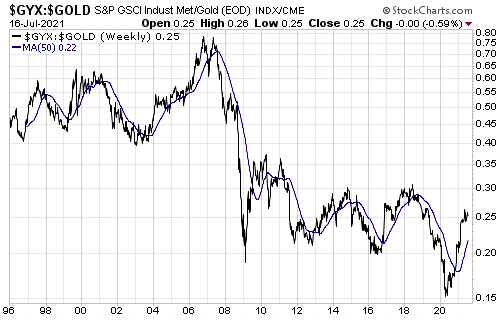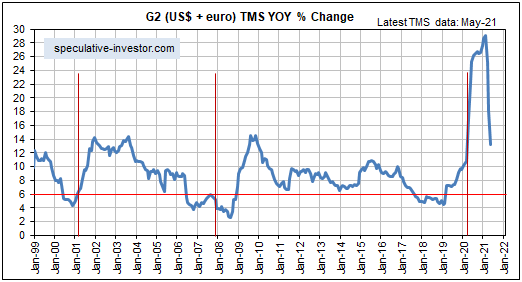[This is a modified excerpt from a commentary published at TSI on 18th July 2021]
One of the most useful intermediate-term indicators of the financial/economic landscape is the performance of industrial metals relative to gold as indicated by the GYX/gold ratio. This ratio turns down prior to financial crises and major economic slowdowns and turns up in the early stages of recoveries. It occasionally makes a ‘head fake’ move, but over the 25 years of its history it has never failed to reverse course in a timely manner.
With reference to the following weekly chart, we define “reverse course” to mean cross from above to below or below to above the 50-week MA (the blue line). For example, GYX/gold turned down ahead of the 1998 Russian/LTCM crisis, the 2001-2002 recession and equity bear market, the 2007-2009 Global Financial Crisis, the 2011-2012 European debt crisis, the 2015 Yuan-devaluation panic, and the Q4-2018 stock market panic that forced the Fed to do an about-face. Note that after turning down ahead of the Q4-2018 panic it didn’t turn back up until the great reflation trade got underway in Q2-2020.
As an aside, ratios that use gold would not be such reliable indicators of important economic and financial-market trends if the gold price were distorted in a big way by manipulation.

Currently there are signs in the equity, bond, commodity and currency markets that a shift away from risk is underway. These signs actually began to appear in March and became more pronounced over the past few weeks. For example, we have been fixating on the ratio of the Russell2000 Small-Cap ETF (IWM) to the S&P500 Large-Cap ETF (SPY), which peaked in March and broke out to the downside early this month. With the early-July downside breakout, this indicator changed from a ‘yellow flag’ to a ‘red flag’ as far as the stock market’s short-term prospects were concerned.
However, there is no evidence in the performance of the GYX/gold ratio that we are dealing with anything more serious than corrections to the major trends that got underway during the second quarter of last year. At least, there isn’t yet.
It’s possible that such evidence will emerge over the months ahead, so we must pay attention to new data and not blindly assume that the future will be a simple extrapolation of the past.
 Print This Post
Print This Post

